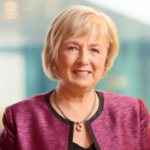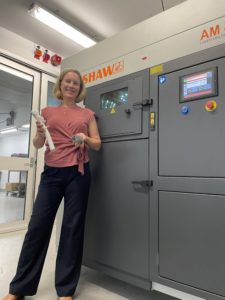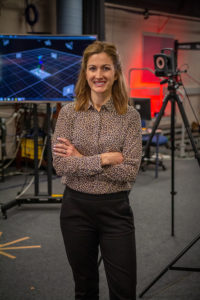
The Precinct’s women leaders and a new generation of female researchers, scientists, clinicians and entrepreneurs are moving innovation, education and healthcare forward, while weighing in on the issues and opportunities that are key to driving change to #BreakTheBias this International Women’s Day #IWD2022. We profile just some of our talent.
New General Manager of Economic Development Queensland, Debbie McNamara, a specialist executive leader across the public and private sector within an infrastructure environment, has joined our Precinct Partnership Group, which includes Griffith University Vice Chancellor and President Professor Carolyn Evans.

Having held Chief Executive and non-Executive Director roles in public and private organisations in Glasgow, and also an Adjunct Professor, Debbie recently led the development and opening of the Surgical, Treatment and Rehabilitation Service (STARS) for Metro North Hospital and Health Service, from inception to being an operational, specialist public health facility.
Other leaders include General Manager of Gold Coast Private Hospital Kimberley Pearce; longtime Principal of the Precinct’s selective state college, the Queensland Academy of Health Sciences Vanessa Rebgetz; and Professor Liz Burd, who joined Griffith’s leadership team in early 2021 and has recently been appointed University Provost. A software engineer, Professor Burd has served on the Institute of Electrical and Electronics Engineers (IEEE) Education Board for five years, and has been a Director for the IEEE Board for the last two years.
New Professors in the Precinct
We welcome some recent additions to our Precinct talent pool:

Professor Carolyn Mountford is a Principal Research Leader at the Institute for Glycomics and a world leader in the development of magnetic resonance (MR) technology addressing unmet needs. In the neuro field she focuses on Post-Traumatic Stress Disorder (PTSD), injury from blast and impact, and pain. Her cancer research focuses on ovarian and breast cancer. Professor Mountford joined Griffith University in 2020.

Professor Chamindie Punyadeera is an inventor and a leader in women in Science Technology, Engineering, Mathematics and Medicine (STEMM). She has had a hybrid research career working in industry and academia and is a globally acknowledged pioneer in salivary diagnostics. Professor Punyadeera joined Griffith in late 2021 as a joint appointment in Sciences and Health.

With a PhD from the University of Cambridge and qualifications from the US and Germany, Professor Stefanie Feih is a materials science expert who has led large industrial research projects in aircraft repair, design for additive manufacturing and polymer composite materials, and led the Polymer Processing Group at the Singapore Institute of Manufacturing Technology (SIMTech) – she joined Griffith in late 2021.
“Over the past four months I have been exposed to a wide range of fantastic initiatives and projects at Griffith University,” Stefanie says.
“Most excitingly, I have become involved in several multi-disciplinary research projects linking engineering sciences to Medtech applications via our Advanced Design and Prototyping Institute (ADaPT), in collaboration with colleagues from Griffith Health.
My research on realistic numerical simulation approaches is transferable and beneficial to guide the simulation and design of advanced implants and prosthetics.
Work-life balance for women in science with families and children will always be a challenge, as our work never really stops. However, sharing my research problems and insights is also a great part of the day. My 10-year-old son recently wrote in a school assignment that “my Mum tells me interesting facts every day”.”
Women in Science giving back
 Early career researcher and biomedical engineer Dr Laura Diamond has some compelling statistics to offer that explain her passion for encouraging women into STEM careers.
Early career researcher and biomedical engineer Dr Laura Diamond has some compelling statistics to offer that explain her passion for encouraging women into STEM careers.
“STEM fields (in particular, engineering) are primarily underrepresented by women due to drop-out at two time points,” Laura says.
In high school, there is a 1:1 ratio of year 10 girls and boys in science, but by year 12 the ratio is 1:2 (girls:boys), leaving less girls pursuing STEM fields at university. Additionally, 40% of early career female engineers (post-PhD) transition into different career paths within 3-5 years of completing their PhD.”
“This reduces the number of women in engineering, and the number of women that continue to senior leadership and decision-making positions.”
The new Mum and 2021 Young Tall Poppy Science Award winner’s research integrates a unique blend of skills in STEM and clinical sciences to identify and modify movement adaptations that are risk factors for musculoskeletal and orthopaedic conditions, including developing a ‘smart’ wearable device to retrain people with hip osteoarthritis.
“I’m part of an exciting nation-wide women in STEM initiative which aims to engage and empower schoolgirls and early career mentors in the field of biomechanics. We initiated a 100-day Biomechanics Research & Innovation Challenge which will give 100 Australian schoolgirls the opportunity to work hands-on with 25 female biomechanists,” Laura says.
“I have been exceptionally fortunate to have many great mentors (both men and women) who have given me the confidence to pursue a career in STEM. My advice to girls and women considering a career in STEM is to be curious!”
For Professor Kate Seib, Research Leader & Associate Director (Research) at Griffith University’s Institute for Glycomics, empowering women is about normalising opportunities.
“The idea of equity, diversity and inclusion needs to be incorporated into people’s everyday lives – from organising small-scale activities to appointing industry CEOs,” Kate says.
“Women have made exceptional contributions to science, yet they are still underrepresented in leadership roles in many areas. This is a loss for everyone – great ideas aren’t coming to light, and the next generation of female scientists don’t have role models to inspire them.
But the newly-minted professor, whose microbiology research focuses on vaccine development and antibiotic resistance, including a gonococcal vaccine, is also optimistic and is actively part of the solution.
“I’ve been involved in organising ‘Soapbox Science’ over the last few years to showcase female scientists and their research to the public,” she says.
“I’ve met so many exceptional women who are making ground-breaking discoveries in science. On top of that, there’s nothing better than seeing children’s reactions to these great women talking about their work.”

Associate Professor Jenny Ekberg is a neuroscientist at Griffith University’s Clem Jones Centre for Neurobiology and Stem Cell Research with more than two decades of experience, and a strong focus on clinical impact.
“To be successful in science these days, we need to focus on the impact and how we can translate our research into clinical products, ” Jenny says.
I spend a lot of time engaging with clinicians, the community and other researchers so that together we can direct our research at the most important questions.”
The Centre, where Jenny is one of two chief investigators alongside Professor James St John, has three main interrelated projects: Spinal Injury Repair, Peripheral Nerve Injury Repair and Neurodegeneration. Jenny’s team have already determined how bacteria can invade the brain via nerves within the nose, and then set off a cascade of events that lead to the onset of Alzheimer’s disease, and are now discovering drug treatments that can reverse or slow the pathologies.
“The biggest challenge for women is that while we have many women in academic and research positions, they tend to be in the lower levels. While this is changing over time with many positive approaches, it does impose at least the perception that the career path for women is less certain.”
It’s something Jenny strives to change in her dual role as Deputy Head of School (Research) at the School of Pharmacy and Medical Science.
Making medical history

Late last year interventional neuroradiologist Dr Laetitia de Villiers became the first woman in the world to perform a robotic-assisted neurovascular aneurysm coil procedure – complex and delicate brain surgery, that is performed as a minimally-invasive procedure.
As one half of a dynamic duo with Director of Interventional Radiology and Gold Coast University Hospital, Dr Hal Rice, she is used to pioneering the way in her specialty, which like many fields of medicine, tends to be male-dominated. Their service is now regarded as one of the premier sites in Australia for the endovascular treatment of life-threatening brain aneurysms and acute ischaemic stroke. Laetitia also has an additional interest in and practices in general and Hepatobiliary Interventional Radiology.
Dr de Villiers (MBChB, FRANZCR) completed her specialist training in Diagnostic and Interventional Radiology at the Princess Alexandra Hospital in Brisbane and an advanced specialist fellowship in Diagnostic and Interventional Neuroradiology at the Mt Sinai Medical Center in New York City in 2007 and 2008, after undertaking her initial medical degree and residency in South Africa.
Laetitia is also an accomplished speaker and Associate Professor at Bond University and Senior Lecturer at Griffith University in their respective medical schools.